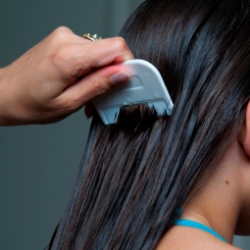
31 May Head Lice – The Problem and Treatment
What’s the Nit-Picking Problem?
Another child and distraught mother materialized right at closing time this week. “He cannot go back to school until it is treated!” the tired working mother bemoaned. Head lice are the scourge of grade schools everywhere, from the ritziest private schools on down. And they are not going anywhere anytime soon. While harmless to the kid, adults go berserk—casting glances of judgment upon the family and banning the child from school and social events. Parents take it particularly hard and are start harboring deep feelings of guilt and question how hygienic their homes and housekeeping skills really are.
Relax.

Head lice are the scourge of grade schools everywhere, from the ritziest private schools on down. And they are not going anywhere anytime soon.
Pediculus humanus capitis, aka Head Lice, are spread by old fashioned human-to-human contact. They cannot fly through the air or leap from one head to another. Anybody can get them. It is not necessarily an indicator of poor hygiene. The Center for Disease Control’s (CDC) official position is that sharing hats and combs is unlikely to spread lice. But why risk it? As my 2nd grade teacher would say, “Would you use someone else’s toothbrush?” And we can’t blame our pets for spreading lice. It seems lice only have a taste for delicious human blood.
To rid ourselves of lice, we have been picking like monkeys since ____ (fill in your personal evolutionary belief here). Head lice infections are believed to have branched off from the common body louse at some point in our remote past. They have accompanied us through the ages, sipping our blood, prowling about our scalps, and freaking us out in general. Many ancient nit combs have been discovered the world over. The Roman naturalist Pliny the Elder (AD 23-79) recommended bathing in viper venom to cure lice (before he was subsequently killed in the eruption of Mount Vesuvius at Pompeii). Even the New World was crawling with lice. The Aztec emperor, Montezuma (1466-1520) reportedly employed peasants to pick nits off the populace. It is stated that he then had them dried and stored in his treasury (surely for some twisted reason since lost to history). The English herbalist, Nicholas Culpepper (1616-54) was a proponent of drowning children’s heads in tobacco juice.
Despite the creepiness factor associated with lice, they are medically harmless. It is said they are more pesky than pestilent. Once believed to transmit typhus, it wasn’t until 1909 that the body louse was correctly identified as the culprit.
Popular media has played a role in stigmatizing those unlucky enough to catch lice.

If your child’s school has a “No Nit” policy, don’t even bother asking for a doctor’s note to try and fight it. Just address the problem and move on with life.
Whenever the police find a corpse on CSI or Murder She Wrote, the autopsy usually concludes the deceased was a homeless hobo when lice are found on the body. An episode of The Office had workers showing up in hazmat suits when a coworker was diagnosed with the cooties. And on the popular cartoon South Park, an infected kid was beaten by his classmates with bars of soap after coming down with nits. I guess lice makes for good television.
What is a Nit?
The infamous nit is actually the egg of the lice. It looks like a tiny white grain of sand or dandruff stuck on the hair shaft. Many times dandruff, eczema, or even dried hairspray can be mistaken as nits. If your child’s school has a “No Nit” policy, don’t even bother asking for a doctor’s note to try and fight it. Just address the problem and move on with life. Luckily many schools have relaxed their nit policy in recent years; recognizing it punished kids and parents alike and fails to halt the spread.
Treating Head Lice
A Google search for “lice treatment” yields about 20 million hits. But there is only one website you need: CDC.gov. Out of all the websites I reviewed, it has the most unbiased and logical information available. So before you start putting mayonnaise or tobacco juice on Junior’s head, or get the clippers out for little Sally, visit the website first.

